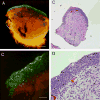Human bladder cancer diagnosis using Multiphoton microscopy
- PMID: 19360140
- PMCID: PMC2666914
- DOI: 10.1117/12.808314
Human bladder cancer diagnosis using Multiphoton microscopy
Abstract
At the time of diagnosis, approximately 75% of bladder cancers are non-muscle invasive. Appropriate diagnosis and surgical resection at this stage improves prognosis dramatically. However, these lesions, being small and/or flat, are often missed by conventional white-light cystoscopes. Furthermore, it is difficult to assess the surgical margin for negativity using conventional cystoscopes. Resultantly, the recurrence rates in patients with early bladder cancer are very high. This is currently addressed by repeat cystoscopies and biopsies, which can last throughout the life of a patient, increasing cost and patient morbidity. Multiphoton endoscopes offer a potential solution, allowing real time, non-invasive biopsies of the human bladder, as well as an up-close assessment of the resection margin. While miniaturization of the Multiphoton microscope into an endoscopic format is currently in progress, we present results here indicating that Multiphoton imaging (using a bench-top Multiphoton microscope) can indeed identify cancers in fresh, unfixed human bladder biopsies. Multiphoton images are acquired in two channels: (1) broadband autofluorescence from cells, and (2) second harmonic generation (SHG), mostly by tissue collagen. These images are then compared with gold standard hematoxylin/eosin (H&E) stained histopathology slides from the same specimen. Based on a "training set" and a very small "blinded set" of samples, we have found excellent correlation between the Multiphoton and histopathological diagnoses. A larger blinded analysis by two independent uropathologists is currently in progress. We expect that the conclusion of this phase will provide us with diagnostic accuracy estimates, as well as the degree of inter-observer heterogeneity.
Figures



Similar articles
-
A pilot study of using multiphoton microscopy to diagnose gastric cancer.Surg Endosc. 2011 May;25(5):1425-30. doi: 10.1007/s00464-010-1409-z. Epub 2010 Nov 3. Surg Endosc. 2011. PMID: 21046158
-
Multiphoton microscopy: a potential intraoperative tool for the detection of carcinoma in situ in human bladder.Arch Pathol Lab Med. 2015 Jun;139(6):796-804. doi: 10.5858/arpa.2014-0076-OA. Arch Pathol Lab Med. 2015. PMID: 26030249
-
Real-time optical diagnosis for surgical margin in low rectal cancer using multiphoton microscopy.Surg Endosc. 2014 Jan;28(1):36-41. doi: 10.1007/s00464-013-3153-7. Epub 2013 Sep 4. Surg Endosc. 2014. PMID: 24002915
-
Value of multiphoton microscopy in uro-oncology: a narrative review.Transl Androl Urol. 2023 Mar 31;12(3):508-518. doi: 10.21037/tau-21-973. Epub 2023 Feb 17. Transl Androl Urol. 2023. PMID: 37032746 Free PMC article. Review.
-
Pretherapeutic evaluation of patients with upper gastrointestinal tract cancer using endoscopic and laparoscopic ultrasonography.Dan Med J. 2012 Dec;59(12):B4568. Dan Med J. 2012. PMID: 23290296 Review.
Cited by
-
Multiphoton microscopy to identify and characterize the transition zone in a mouse model of Hirschsprung disease.J Pediatr Surg. 2013 Jun;48(6):1288-93. doi: 10.1016/j.jpedsurg.2013.03.025. J Pediatr Surg. 2013. PMID: 23845620 Free PMC article.
-
A pilot study of using multiphoton microscopy to diagnose gastric cancer.Surg Endosc. 2011 May;25(5):1425-30. doi: 10.1007/s00464-010-1409-z. Epub 2010 Nov 3. Surg Endosc. 2011. PMID: 21046158
-
Discovery and Characterization of Human Amniochorionic Membrane Microfractures.Am J Pathol. 2017 Dec;187(12):2821-2830. doi: 10.1016/j.ajpath.2017.08.019. Epub 2017 Sep 20. Am J Pathol. 2017. PMID: 28939208 Free PMC article.
-
In vivo imaging of unstained tissues using a compact and flexible multiphoton microendoscope.J Biomed Opt. 2012 Apr;17(4):040505. doi: 10.1117/1.JBO.17.4.040505. J Biomed Opt. 2012. PMID: 22559671 Free PMC article.
-
Strategies for high-resolution imaging of epithelial ovarian cancer by laparoscopic nonlinear microscopy.Transl Oncol. 2010 Jun 1;3(3):181-94. doi: 10.1593/tlo.09310. Transl Oncol. 2010. PMID: 20563260 Free PMC article.
References
-
-
“American Cancer Society: Cancer Facts and Figures”. (1995).
-
-
- Nieder AM, Soloway MS. Eliminate the term “superficial” bladder cancer. Journal of Urology. 2006;175(2):417–8. - PubMed
-
- Lee CSD, Yoon CY, Witjes JA. The past, present and future of cystoscopy: the fusion of cystoscopy and novel imaging technology. BJU International. 2008;102:1228–33. - PubMed
-
- Kwast TH. Urine markers for bladder cancer surveillance: a systematic review. European Urology. 2005;47:736–48. - PubMed
-
- Botteman MF, et al. The health economics of bladder cancer: a comprehensive review of the published literature. Pharmacoeconomics. 2003;21(18):1315–30. - PubMed
Grants and funding
LinkOut - more resources
Full Text Sources
